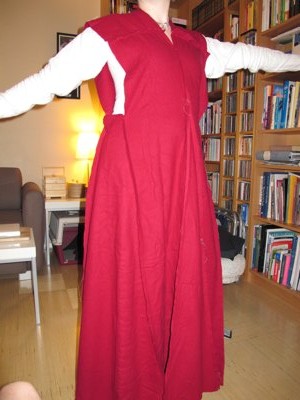On ollut vaikea malttaa kirjoittaa kun olen niin kovalla touhulla tehnyt uutta Moy-mekkoani. Moy-mekko on nimeltään Moy-mekko, koska sen esikuva on löydetty Moyn suosta Irlannista. Homma on haastavaa siksi, ettei tästä mekosta ole julkaistu kirjaa. Onneksi siitä on verkossa aika paljon harrastajien hankkimaa arvokasta tietoa. Niillä mennään!
Monet ovat tehneet mekon hieman erikoisesta yläosasta kaavan mekkoa tehdessään, mutta ajattelin itse tarttua vähän toiseen lähestymistapaan. Teen ensin mekon vartalo-osan ja sitten hihat. Istutan hihat asiankuuluvasti ja sitten leikkaan ylimääräisen pois. Tässä on suunnitelma tähän asti. Tuntuu vähän anarkistiselta mennä heti villan kimppuun, mutta hyvin se on tähän asti mennyt.
Kuvia:


Mekossa ei ole olkasaumaa, vaan etu- ja takakappaleet ovat kiinni toisissaan rintakehän päällä.

Mekossa on paljon vähemmän saumaa kuin Herjolfsnesin mallin mukaan tehdyissä mekoissa – sitä myötä vähemmän mutta silti riittävästi helmaa. Sen hyvä puoli on keveys, jota vuorittamattomuus korostaa entisestään.
Näiden kuvien jälkeen olen leikannut kaula-aukon, kääntänyt saumaa, tehnyt silkkinyörin metallikärjellä, vahvistanut ja huolitellut kaula-aukkoa ja nyörityksen paikkaa. Nyt mekko on tökitty täyteen paksuhkojoa sukkapuikkoja, jotka venyttelevät nyörinreikiä. Kohta alkaa olla hihojen kaavoituksen aika!
***
I’ve found it hard to concentrate on blogging when I’ve been so busy working on my Moy bog dress. The dress is named after an Irish bog, where the original piece was found. There is unfortunately no literature available on the dress, but fortunately there is quite some valuable info online that has been compiled by re-enactors and other aficionados.
A lot of people that have made a similar dress have made a mockup to draft a pattern for the top part of the dress. I decided to try another route. I’ll make the dress and the sleeves and then fit them to each other and so far at least my logic says that should result in a similar result than drafting a separate pattern and working from that. It seems slightly anarchistic to hit the wool to begin with, but this far it has gone well.
After these pictures were taken I’ve cut out the neckline, reinforced it and the front opening, made a silk lace with a brass tip and finished quite a few seams. Right now the dress is poked full of knitting needles that are stretching the lacing holes open. (I decided to make a laced dress instead of a buttoned up one) Soon it’ll be time to move on to making the sleeves!
The pics illustrate various phases in the making of the dress. As you can see in them, there really is no shoulder seam, but the seam is placed lower, on the chest. Compared to the Herjolfsnes patterns this has a lot less seams, a little less hem and what feels most important – it is a lot lighter, especially since it isn’t lined.

Question: You mention that the dress was not lined. Is it possible that it was and the lining just hasn’t survived or is there some kind of evidence in the fragments that points towards no lining?
I tried the same approach with my Herjolfsnäs-gown with great results, starting with rectangles and triangels. All though I didn’t have the guts to start with the wool. :)
I’m looking forward to more pictures.